Introduction
Boiled squid, known in Chinese cuisine as 白灼鱿鱼 (Bái zhuó yóuyú), is a dish that celebrates simplicity, freshness, and the natural flavors of the ocean. Rooted in Cantonese cooking traditions, this method emphasizes minimal interference with the ingredient, allowing the squid’s delicate taste and tender texture to shine. Unlike frying or grilling, which can mask the squid’s inherent qualities, boiling—or 灼 (zhuó)—preserves its integrity while delivering a dish that is both visually appealing and satisfyingly light.
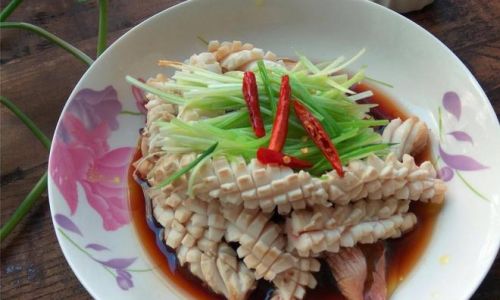
The appeal of 白灼鱿鱼 lies in its versatility. It can serve as an elegant appetizer at banquets, a quick weeknight dinner, or a refreshing addition to a summer meal. Its preparation requires precision but little complexity, making it accessible to home cooks of all skill levels. This article will guide you through selecting the finest ingredients, mastering the cooking technique, and elevating the dish with complementary flavors. By the end, you’ll understand why this dish has earned its place as a beloved staple in Chinese kitchens and beyond.
Ingredients: Quality Matters
The foundation of exceptional 白灼鱿鱼 begins with sourcing the freshest squid. Opt for whole, medium-sized squid (approximately 6–8 inches in length) with glossy skin, firm flesh, and a mild, oceanic scent. Frozen squid can be used if fresh is unavailable, but ensure it is thoroughly thawed and patted dry before cooking.
For the Squid:
- 1 pound (450g) fresh or thawed squid (cleaned weight)
- 1 tablespoon kosher salt (for cleaning)
- 4 cups water (for boiling)
- 3 slices fresh ginger
- 2 scallions, white and green parts separated, cut into 2-inch segments
- 1 tablespoon rice wine or dry sherry (optional, for enhancing flavor)
For the Dipping Sauce:
- 3 tablespoons light soy sauce
- 1 tablespoon Chinese black vinegar (or substitute with rice vinegar)
- 1 teaspoon sesame oil
- 1 small garlic clove, minced
- 1 teaspoon fresh ginger, grated
- 1 red chili pepper, thinly sliced (optional, for heat)
- 1 teaspoon sugar (optional, to balance acidity)
- 1 tablespoon cilantro leaves, chopped (for garnish)
Equipment:
- Large pot
- Slotted spoon or spider strainer
- Ice bath (a large bowl filled with ice and water)
- Sharp knife and cutting board
Step-by-Step Preparation
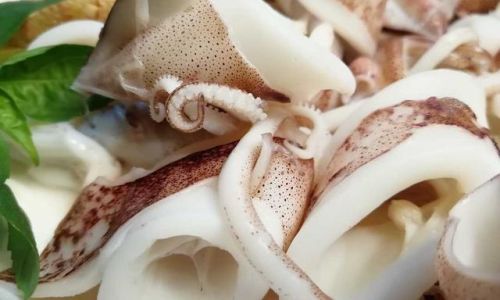
Cleaning the Squid
Proper cleaning is essential to eliminate any bitterness or grit. Start by rinsing the squid under cold water. Gently pull the head away from the body; the entrails should come out with it. Discard the ink sac (unless preparing a sauce with it) and the clear, plastic-like quill inside the body. Remove the eyes and beak from the head, then rinse the tentacles thoroughly.
For the body, peel off the purple or grayish skin using your fingers or a small knife. This step is crucial, as the skin can toughen during cooking. If the squid has wings (flaps along the sides), trim them to create even slices later.
Preparing the Cooking Liquid
Fill a large pot with 4 cups of water and bring it to a rolling boil over high heat. Add the ginger slices, scallion whites, and rice wine (if using). These aromatics will subtly infuse the squid, eliminating any fishy odor without overpowering its flavor.
Cooking the Squid: Timing Is Key
Squid cooks incredibly quickly—overcooking by even 30 seconds can transform tender flesh into rubber. Once the water boils, reduce the heat to maintain a gentle simmer. Using tongs, carefully lower the squid into the pot. Cook for 5–2 minutes, depending on size. The squid is ready when it turns opaque, the flesh firms slightly, and the tentacles curl inward.
Shocking in Ice Water
Immediately transfer the cooked squid to the ice bath. This step halts the cooking process, preserving the squid’s texture and vibrant color. Let it chill for 2–3 minutes, then drain thoroughly.
Slicing and Presentation
Pat the squid dry with paper towels. Using a sharp knife, cut the body into ¼-inch rings. Slice the tentacles into bite-sized pieces if desired. Arrange the squid on a serving platter, garnished with scallion greens and cilantro.
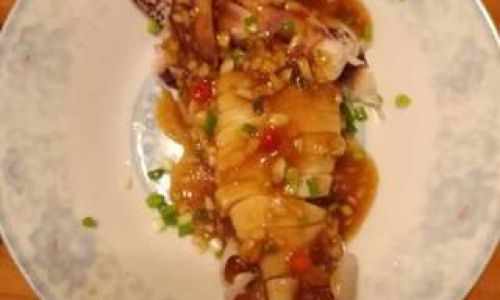
Crafting the Dipping Sauce
While the squid cooks, prepare the sauce. Combine soy sauce, vinegar, sesame oil, garlic, ginger, chili (if using), and sugar in a small bowl. Stir until the sugar dissolves. Adjust the balance to taste—some prefer a tangier profile, while others lean into sweetness or spice.
Expert Tips for Perfection
- Avoid Overcrowding the Pot: Cook squid in batches if needed. Overcrowding lowers the water temperature, leading to uneven cooking.
- Test Doneness with Precision: The squid’s flesh should resist slightly when pressed but still feel tender. Overcooked squid will shrink and become chewy.
- Enhance Flavor with Aromatics: Experiment with adding lemongrass, kaffir lime leaves, or star anise to the cooking liquid for aromatic variations.
- Serve Immediately: Squid is best enjoyed fresh. Letting it sit can cause the flesh to toughen.
Serving Suggestions
白灼鱿鱼 shines when paired with contrasting textures and flavors. Serve it alongside:
- Steamed jasmine rice or sticky rice.
- Blanched vegetables like bok choy or snow peas.
- A crisp green salad dressed with a sesame-ginger vinaigrette.
- As part of a dim sum spread with dumplings and spring rolls.
For beverages, pair with a light white wine like Sauvignon Blanc, a chilled lager beer, or jasmine tea to cleanse the palate.
Health Benefits of Squid
Beyond its culinary appeal, squid offers notable nutritional advantages:
- Low in Calories, High in Protein: A 3-ounce serving provides 13g of protein with only 78 calories.
- Rich in Vitamins and Minerals: Squid is a source of vitamin B12, selenium, copper, and zinc, which support immune function and metabolism.
- Heart-Healthy Nutrients: Its omega-3 fatty acids contribute to cardiovascular health.
Common Mistakes to Avoid
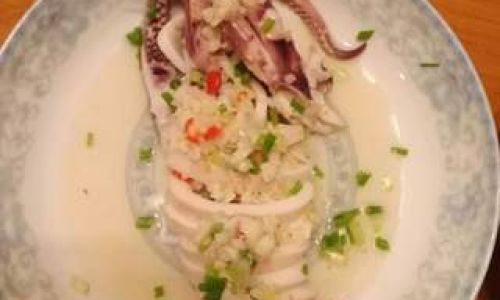
- Using Frozen Squid Without Thawing: Rapid temperature changes can toughen the flesh. Thaw squid slowly in the refrigerator.
- Skipping the Ice Bath: This step is non-negotiable for achieving the ideal texture.
- Over-Seasoning the Cooking Water: Salt can draw moisture from the squid, making it dense. Season the dipping sauce instead.
- Using Dull Knives: A sharp blade ensures clean cuts without tearing the delicate flesh.
Variations to Explore
- Spicy Szechuan Twist: Add Szechuan peppercorns and dried chilies to the cooking liquid for a numbing heat.
- Citrus Infusion: Squeeze fresh lime juice into the dipping sauce and garnish with lime wedges.
- Herbaceous Finish: Toss the squid with fresh basil, mint, or dill before serving.
- Vegetarian Adaptation: Substitute squid with king oyster mushroom stems, sliced and cooked similarly for a meat-free alternative.
Cultural Context
In Chinese cuisine, 灼 (zhuó) represents a cooking philosophy centered on respect for ingredients. By using minimal heat and seasoning, chefs highlight the produce’s true essence. This method is particularly revered in coastal regions like Guangdong, where seafood abundance inspires culinary creativity. 白灼鱿鱼 often graces festive tables during Lunar New Year, symbolizing abundance and the joy of shared meals.
Conclusion
白灼鱿鱼 is more than a dish—it’s a testament to the beauty of simplicity. Mastering its preparation requires patience and attention to detail, but the rewards are immense. Whether you’re a novice cook or a seasoned chef, this recipe offers a gateway to exploring Chinese culinary techniques while delighting in the ocean’s bounty. So boil that water, sharpen your knife, and savor the briny sweetness of perfectly cooked squid. Your taste buds—and dinner guests—will thank you.
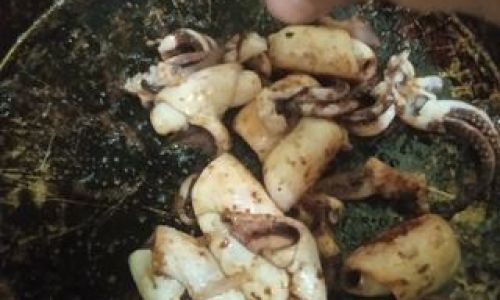

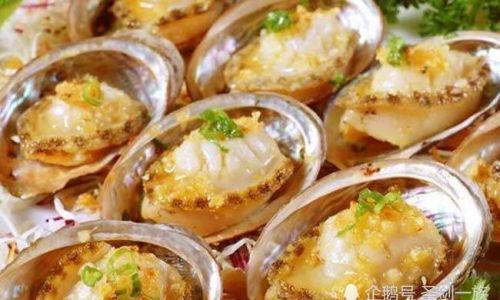

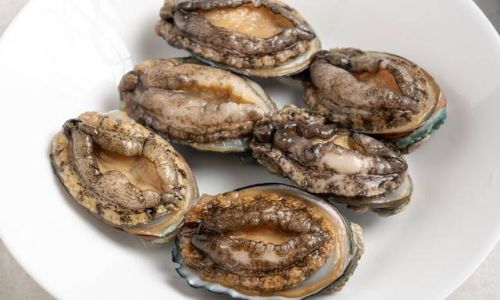
0 comments